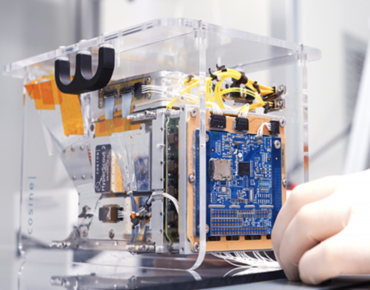Space-Based AI Sharpens Earth Observations

Source: Intel
There are countless eyes on the sky, but the European Space Agency (ESA) and its technology partners that include Intel Corp. claim to be the first to apply AI inference to the emerging field of hyperspectral imaging of the Earth’s surface.
The ESA and its partners are using the maiden flight of its PhiSat-1 satellite as a testbed for future satellite communications and for developing new space-based AI applications.
The ESA launched the AI-powered CubeSat in early September as part of a satellite “ride-share” initiative. Lofted on an Arianespace Vega rocket, the cereal box-sized satellite carries an Intel Movidius vision processing unit that accelerates AI inference algorithms to help a hyperspectral-thermal camera filter and discard cloudy images.
PhiSat-1 is stationed in a sun-synchronous orbit. From an altitude of about 329 miles, it along with a second CubeSat will monitor polar ice and soil moisture. It is also serving as a testbed for satellite communications links that could one day connect a network of satellites.
The space-based AI effort attacks two problems: the exponential growth of space-based sensor data and the limited amounts of download bandwidth.
Along with ESA, Intel worked with Ubotica, an AI and computer vision developer based in Dublin, Ireland. Among the challenges was handling the huge volume of cloudy and therefore useless imagery. About 70 percent of satellite imagery is obscured by clouds, wasting bandwidth and research time.
The partners are using AI algorithms and the onboard Movidius Myriad chip to scan images, then identify and discard cloudy ones, transmitting only those the capture useful data. The process is estimated to reduce precious download bandwidth demand—and waste—by 30 percent.
“Artificial intelligence at the edge came to rescue us,” said Gianluca Furano, head of ESA’s data systems and onboard computing effort. "The capability that sensors have to produce data increases by a factor of 100 every generation, while our capabilities to download data are increasing, but only by a factor of three, four, five per generation." Among the remedies is reducing bandwidth demand by adding a measure of autonomy to satellite functions. To do that, on-board decision making rather than relying on ground controllers has enabled pre-filtering of Earth observation data so that only relevant images with usable information are downlinked to the ground, said Furano. That improves bandwidth utilization and significantly reduces aggregated downlink costs, he added.
Among the remedies is reducing bandwidth demand by adding a measure of autonomy to satellite functions. To do that, on-board decision making rather than relying on ground controllers has enabled pre-filtering of Earth observation data so that only relevant images with usable information are downlinked to the ground, said Furano. That improves bandwidth utilization and significantly reduces aggregated downlink costs, he added.
Following a Sept. 2 launch from French Guiana, the CubeSat underwent initial verification by saving all imagery while recording its AI cloud detection decision for each image. Researchers on the ground then verified that the AI inference system was performing as expected.
In late September, ESA announced its first hardware-accelerated AI inference platform for Earth observation. The AI-based system is based on a deep convolutional neural network developed at the University of Pisa.
The cloud detection system sorted hyperspectral imagery from CubeSat sensors into cloud and non-cloud pixels, downlinking only the latter.
The CubeSat also serves as a prototype for a range of potential AI-based satellite services. “Rather than having dedicated hardware in a satellite that does one thing, it’s possible to switch networks in and out,” said Jonathan Byrne, who heads Intel’s Movidius technology unit.
Hence, ESA and Ubotica are working on PhiSat-2 that would carry another Myriad VPU to orbit. The mission would test whether AI applications could be developed, installed and validated on-the-fly via a ground-based user interface.
Related
George Leopold has written about science and technology for more than 30 years, focusing on electronics and aerospace technology. He previously served as executive editor of Electronic Engineering Times. Leopold is the author of "Calculated Risk: The Supersonic Life and Times of Gus Grissom" (Purdue University Press, 2016).










